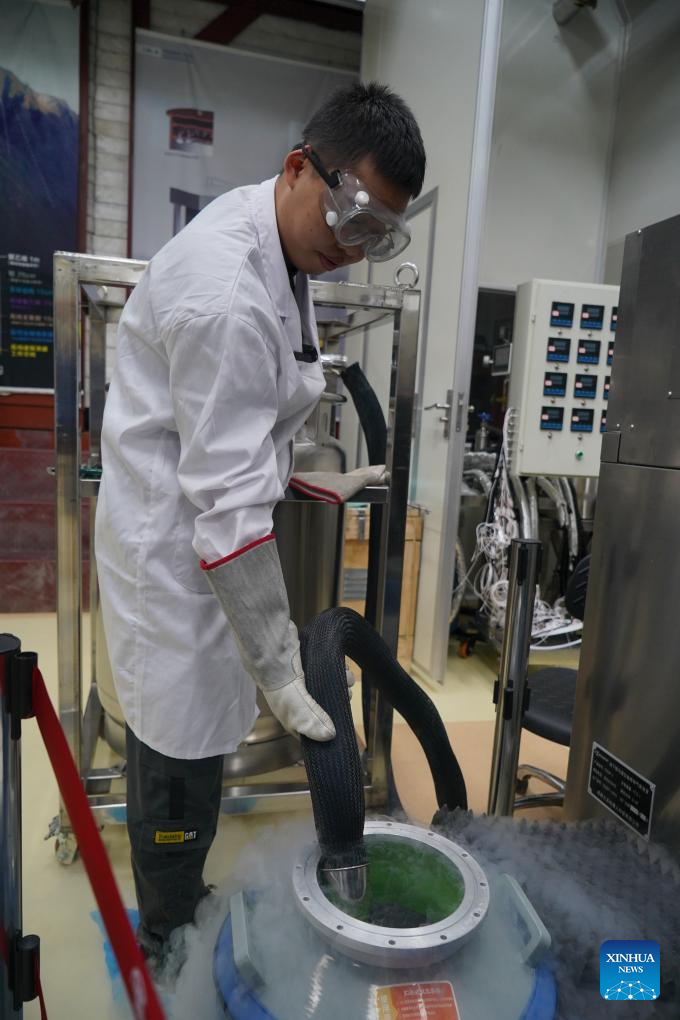Building "shield" for physics lab 2,400 meters underground

Workers are seen at the construction site of the second phase of the China Jinping Underground Laboratory in southwest China's Sichuan Province, Sept. 19, 2023. Nestled beneath the Jinping Mountain near the Yalong River in southwest China's Sichuan Province, an advanced physics laboratory designed to unveil the mysteries of the universe is currently under construction deep underground. (Xinhua/Xue Chen)
CHENGDU, Sept. 27 (Xinhua) -- Nestled beneath the Jinping Mountain near the Yalong River in southwest China's Sichuan Province, an advanced physics laboratory designed to unveil the mysteries of the universe is currently under construction deep underground.
Located 2,400 meters beneath the surface of the mountain and surrounded by rocks, the China Jinping Underground Laboratory (CJPL) has recently witnessed the completion of a polyethylene shield cabin, a key part of CJPL's second phase construction.
The first phase of the laboratory was completed and put into use at the end of 2010, with a room capacity of about 4,000 cubic meters. It has made a number of scientific achievements, elevating China's dark matter direct detection experiments to an advanced level on the global stage.
The second phase, or the Deep Underground and Ultra-low Radiation Background Facility for Frontier Physics Experiments, started construction in December 2020, with a total room capacity of about 330,000 cubic meters. It is scheduled to be completed and put into use in 2024.
A standard laboratory will be built in the second phase with the advantages of extremely low radon concentration, extremely low environmental radiation, ultra-low cosmic ray flux and ultra-clean space. In addition to dark matter research, studies on neutrino detection, deep underground medical science and rock mechanics will also be carried out in the lab.
Thanks to surrounding rocks as thick as 2,400 meters, the CJPL is exposed to a tiny flux of cosmic rays which is only a 100,000,000th of that on the surface. Reducing environmental radiation from surrounding rocks is critical to the lab.
The builders have adopted multiple measures to minimize the radiation impact on the extremely low-radiation environment, such as water prevention, radon control, and the use of construction materials with low radiation.
"These measures are not enough to guarantee a low radiation environment for a science lab," said Tan Lei, chief engineer of the second phase project. "We need a shielding device with extremely low radiation background. The polyethylene shield is one of the key parts of the most 'pure' laboratory."
The largest of its kind in the world, the shield cabin is 51.9 meters long, 9.78 meters wide, 7.9 meters high and 1 meter thick. It is mainly composed of high-density polyethylene plates with a thickness of 100 millimeters. The total consumption of polyethylene plates is about 1,850 cubic meters, weighing more than 1,800 tonnes.
The construction of the shield cabin requires no continuous joint between the polyethylene plates. The project contractor used Building Information Modeling technology to divide the cabin into more than 10,000 parts by computer modeling and found a way to put all the plates together without a continuous joint.
The contractor also worked with Tsinghua University and Sichuan University to apply the thermal-mechanical coupling theory to construction model analysis and calculation, and found the solution to the construction of a polyethylene shield cabin.
The construction of the second phase is nearing completion, with the installation of electronic and mechanical equipment and pipelines in progress. A research team from Shanghai Jiaotong University is already stationed there to prepare the liquid-xenon dark matter detector for future experiments.
After completion, the CJPL will become a top-tier underground experiment platform with the deepest rock coverage, the lowest cosmic ray flux and the largest available space for research on particle and nuclear physics, astrophysics and cosmology.

A researcher works at the China Jinping Underground Laboratory in southwest China's Sichuan Province, Sept. 19, 2023. Nestled beneath the Jinping Mountain near the Yalong River in southwest China's Sichuan Province, an advanced physics laboratory designed to unveil the mysteries of the universe is currently under construction deep underground. (Xinhua/Xue Chen)

A researcher conducts experiment at the China Jinping Underground Laboratory in southwest China's Sichuan Province, Sept. 19, 2023. Nestled beneath the Jinping Mountain near the Yalong River in southwest China's Sichuan Province, an advanced physics laboratory designed to unveil the mysteries of the universe is currently under construction deep underground. (Xinhua/Xue Chen)
Photos
Related Stories
- Chinese team grabs 5 gold medals at Int'l Physics Olympiad
- Chinese researchers reproduce solar-flare features in lab
- Two Chinese achievements among top 10 breakthroughs of 2022 in physics
- A close look at world's deepest laboratory in Sichuan
- Physicist named first Australian Blaise Pascal Medal recipient
Copyright © 2023 People's Daily Online. All Rights Reserved.









